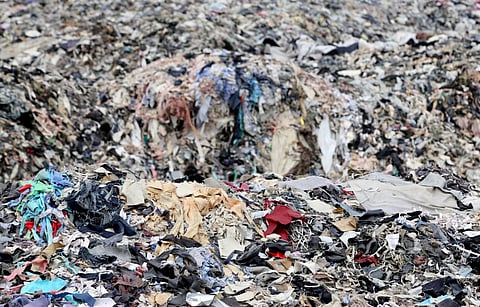Panipat recycles over one lakh tonnes of global textile waste annually, turning discarded garments into low-grade yarn and products.
Developed nations export textile waste to India under the guise of recycling, shifting environmental and economic burdens—a clear case of waste colonisation.
Toxic bleaching and untreated wastewater from Panipat’s recycling units contaminate groundwater, agricultural soil and ecosystems, threatening public health and livelihoods.
Panipat’s Booming Textile Recycling Industry: How Waste Colonisation is Polluting India’s Rivers
India’s Panipat recycles global textile waste but toxic processes and “waste colonisation” are choking rivers and ecosystems
Widely known as the cast-off capital of the world, Panipat is one of the biggest processing hubs of textile waste globally. Recycling units in the city process over one lakh tonnes of textile every year, according to NDTV.
The processing units in this region receive regular shipments of discarded clothes along with cloth scraps from factories in the US, the UK, Canada, Europe, China and Japan. For context, the US generates about 17 million tonnes of textile waste; China generates around 20 million tonnes; while Italy and Germany contribute around 465,000 tonnes and 390,000 tonnes, respectively. Elsewhere, Japan generated a total of 798,000 tonnes of new clothing in 2022, of which approximately 485,000 tonsnes of such clothing was discarded without reuse, as per a survey by the Environment Ministry. While a major chunk of this textile waste gets discarded without reuse, a portion of it is shipped to India for recycling.
All of this textile material shipped to India is then processed into yarn, and further sold in the markets of Tanda (Uttar Pradesh), Solapur (Maharashtra), and Tiruppur (Tamil Nadu). However, being of low quality, the recycled yarn is only used in making blankets, cushions, bed sheets, and carpets among other products.
“Shoddy yarn, made from short and weak fibres, is often downcycled into low-grade products,” Kriti Srivastava, Assistant Professor at NIFT Kangra told The Hindu.
“This isn’t just inefficient recycling, it’s a form of waste colonisation, where developed countries offload their textile waste onto the Global South, burdening already vulnerable nations with environmental and economic costs,” added Srivastava.
What is Waste Colonisation?
Fast fashion is a business model that encourages buying cheap, trendy clothes and discarding them after only a few wears. This model has resulted in a surge in textile waste generation. Globally, over 100 billion garments are produced annually, generating about 92 million tonnes of textile waste each year, most of which ends up in landfills or is exported to Global South countries for recycling, according to a 2023 report published by Earth.org.

The developed countries export their waste to the developing countries due to lower labour costs and less stringent environmental regulation to process their textile waste in large numbers. This practice–known as waste colonialism or waste dumping–involves sending waste material under the guise of trade, recycling or aid to nations that are ill-equipped to handle it, according to Greenpeace.
This practice lets developed countries avoid the economic and environmental cost of waste disposal or recycling. However, developing countries have to bear the brunt of recycling this waste material as the recycling process generates significant amount of harmful by-products that degrade natural resources while polluting the environment and choking public health systems. The practice is not limited to textiles, as mountains of toxic material in the form of electronic appliances, plastic packaging, scrap metal, automotive tires, textiles and other hazardous waste are also shipped from advanced economy countries to regions in the Global South stretching from Morocco to Ghana and even Vietnam to Turkey, including India and Bangladesh.
Harmful Process
In the case of textiles, recycling garments and cloth scraps involves bleaching, a process that has a number of negative outcomes for the recycled material as well as the surrounding environment.
According to a Science Direct study, the wastewater from recycling is extremely toxic. It comprises suspended solids, chemical oxygen demand (COD), dyes, different chemicals and high concentration of heavy metals like cadmium, zinc, antimony, copper and nickel, among others.
These effluents pollute water bodies and make the water unusable for irrigation purposes. In addition, the excessive content of textile dyes and other chemicals in water bodies affects the marine life present in them, while restricting the photosynthesis ability of plants and algae.
The bleaching process further produces industrial wastewater which includes fats, bleaching agents, dyes and detergents. Some bleaching chemicals, particularly chlorine-based ones, such as like sodium hypochlorite, release highly toxic and non-biodegradable organochlorine compounds that could impact aquatic ecosystems and be potentially carcinogenic to humans.
Going with the Flow
Typically, traditional bleaching methods often require large amounts of water and energy, especially when conducted at high temperatures, which adds to the negative environmental impact of the process.
In the absence of a safe outlet for the disposal of the chemical-laden waste water, the industrial waste is just allowed to flow into nearby drains, and eventually mix with larger rivers, in this case the Yamuna. The impact around Panipat is magnified multifold due to the presence of several illegal bleaching units operating around Panipat’s periphery.

“This highly contaminated water is just allowed to seep underground, polluting the groundwater, or is drained into open land and local drains. It eventually travels to Drain 2 that merges with the Yamuna,” Varun Gulati, a Delhi-based environmentalist told The Hindu. These units operate on agricultural land leased from the farmers.
Around 80% of wastewater is released in the environment with no prior treatment, ultimately impacting water quality, which eventually impacts natural ecosystems. Considering the hazardous effects of wastewater, textile wastewater treatment is incredibly crucial for the environmental protection, and for reuse in activities like agricultural irrigation, landscaping etc. The effluent-laden wastewater from the textile recycling industry can be incredibly harmful for cultivation of crops and agriculture soil, eventually affecting human health.
Global Waste Burden Shifts
Fashion industry has been named as the second most polluting of all industries by the United Nations for generating 8% of all carbon emissions and 20% of all global wastewater.
The increase in fast fashion has turned the textile industry to be among one of the most polluting in the world. This pollution is not just limited to the textile manufacturing and recycling units. It also occurs on an everyday basis, in instances like washing clothes, which release chemicals and microplastics into household wastewater. According to a publication from the European Parliament, “one load of laundry of polyester clothes can discharge 700,000 microplastic fibres, which can end up in human food chain.”
In the case of textile waste discarded to landfills and micro-dumps of developing countries by developed countries, for every 92 million tonnes of textile waste produced globally, only a fraction is recycled. Such recycling hubs are found in the outskirts of Iquique and Alto Hospicio in northern Chile, Ghana’s Kantamanto Market, Kenya’s Dandora dumpsite and second-hand clothing landfills in Kandla, India, where mountains of discarded clothing cover the landscape. The open-air burning of this waste also has a harmful effect on both public health and the environment.
In India, other textile waste recycling hubs include Ludhiana in Punjab known for wool and synthetic recycling; Surat in Gujarat known for synthetic textile waste recycling; Tanda in Uttar Pradesh involved in processing and converting recycled yarn into fabrics and blankets; and Tiruppur in Tamil Nadu known for wool and synthetic recycling.
A significant amount of these garments consists of second-hand clothing or items discarded by the industry.
Mitigating Environmental Impact
However, it’s not all doom and gloom. Efforts have also been made to develop and deploy more environmentally friendly bleaching methods in the textile hubs of Tiruppur, Surat, Panipat and Ludhiana. Knitwear and garment processing units in Bengaluru and Tiruppur are adopting enzymatic bleaching to meet export buyers’ eco-certification demands.
Oxygen and Ozone Bleaching are also being considered to be integrated in a few processing clusters, while ozone-based bleaching has been used in denim finishing in Gujarat and is slowly being adopted for other textile segments.
Moreover, optimised processes are common in export-oriented mills, including adjustable parameters like pH, temperature and chemical concentration.
Wastewater Reuse and Zero Liquid Discharge are mandatory in all common effluent treatment plants (CETPs) in Tiruppur and being expanded to other hubs with some units recycling rinse waste for scouring and bleaching.
A Science Direct study stated that adopting circular textile practices that once came naturally in Indian households extended a garment's life by repeated use and repurposing into items like dusting cloths, quilts or doormats before eventual disposal.
Research by WRAP (Waste and Resources Action Programme), a UK-based NGO shows that extending the lifespan of a garment by just nine months can reduce its carbon, water and waste footprints by up to 20%. Making conscious consumption and going back to basics of the 3Rs—Reduce (buy less, choose quality), Reuse (extend garment life, upcycle) and Recycle (responsible end-of-life processing)—could help tackle textile waste in the long run. Typically, traditional bleaching methods often require large amounts of water and energy, especially when conducted at high temperatures, which adds to the negative environmental impact of the process.
In the absence of a safe outlet for the disposal of the chemical-laden waste water, the industrial waste is just allowed to flow into nearby drains, and eventually mix with larger rivers, in this case the Yamuna. The impact around Panipat is magnified multifold due to the presence of several illegal bleaching units operating around Panipat’s periphery.
“This highly contaminated water is just allowed to seep underground, polluting the groundwater, or is drained into open land and local drains. It eventually travels to Drain 2 that merges with the Yamuna,” Varun Gulati, a Delhi-based environmentalist told The Hindu. These units operate on agricultural land leased from the farmers.
Around 80% of wastewater is released in the environment with no prior treatment, ultimately impacting water quality, which eventually impacts natural ecosystems. Considering the hazardous effects of wastewater, textile wastewater treatment is incredibly crucial for the environmental protection, and for reuse in activities like agricultural irrigation, landscaping etc. The effluent-laden wastewater from the textile recycling industry can be incredibly harmful for cultivation of crops and agriculture soil, eventually affecting human health.




